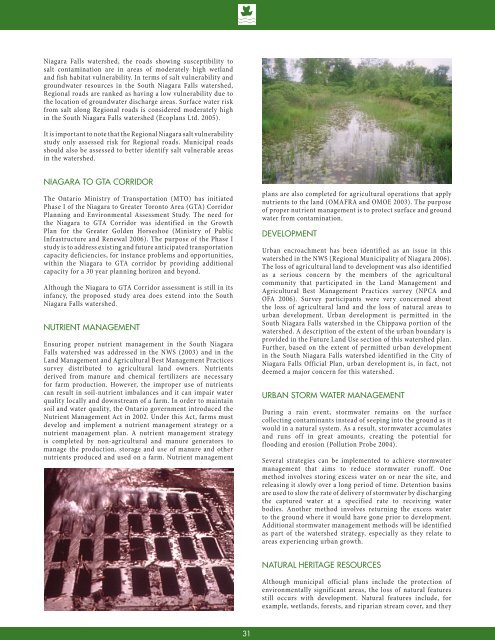8132 - NPCA SNF Watershed Report.indd - Niagara Peninsula ...
8132 - NPCA SNF Watershed Report.indd - Niagara Peninsula ...
8132 - NPCA SNF Watershed Report.indd - Niagara Peninsula ...
Create successful ePaper yourself
Turn your PDF publications into a flip-book with our unique Google optimized e-Paper software.
<strong>Niagara</strong> Falls watershed, the roads showing susceptibility tosalt contamination are in areas of moderately high wetlandand fish habitat vulnerability. In terms of salt vulnerability andgroundwater resources in the South <strong>Niagara</strong> Falls watershed,Regional roads are ranked as having a low vulnerability due tothe location of groundwater discharge areas. Surface water riskfrom salt along Regional roads is considered moderately highin the South <strong>Niagara</strong> Falls watershed (Ecoplans Ltd. 2005).It is important to note that the Regional <strong>Niagara</strong> salt vulnerabilitystudy only assessed risk for Regional roads. Municipal roadsshould also be assessed to better identify salt vulnerable areasin the watershed.<strong>Niagara</strong> to GTA CorridorThe Ontario Ministry of Transportation (MTO) has initiatedPhase I of the <strong>Niagara</strong> to Greater Toronto Area (GTA) CorridorPlanning and Environmental Assessment Study. The need forthe <strong>Niagara</strong> to GTA Corridor was identified in the GrowthPlan for the Greater Golden Horseshoe (Ministry of PublicInfrastructure and Renewal 2006). The purpose of the Phase Istudy is to address existing and future anticipated transportationcapacity deficiencies, for instance problems and opportunities,within the <strong>Niagara</strong> to GTA corridor by providing additionalcapacity for a 30 year planning horizon and beyond.Although the <strong>Niagara</strong> to GTA Corridor assessment is still in itsinfancy, the proposed study area does extend into the South<strong>Niagara</strong> Falls watershed.Nutrient ManagementEnsuring proper nutrient management in the South <strong>Niagara</strong>Falls watershed was addressed in the NWS (2003) and in theLand Management and Agricultural Best Management Practicessurvey distributed to agricultural land owners. Nutrientsderived from manure and chemical fertilizers are necessaryfor farm production. However, the improper use of nutrientscan result in soil-nutrient imbalances and it can impair waterquality locally and downstream of a farm. In order to maintainsoil and water quality, the Ontario government introduced theNutrient Management Act in 2002. Under this Act, farms mustdevelop and implement a nutrient management strategy or anutrient management plan. A nutrient management strategyis completed by non-agricultural and manure generators tomanage the production, storage and use of manure and othernutrients produced and used on a farm. Nutrient managementplans are also completed for agricultural operations that applynutrients to the land (OMAFRA and OMOE 2003). The purposeof proper nutrient management is to protect surface and groundwater from contamination.DevelopmentUrban encroachment has been identified as an issue in thiswatershed in the NWS (Regional Municipality of <strong>Niagara</strong> 2006).The loss of agricultural land to development was also identifiedas a serious concern by the members of the agriculturalcommunity that participated in the Land Management andAgricultural Best Management Practices survey (<strong>NPCA</strong> andOFA 2006). Survey participants were very concerned aboutthe loss of agricultural land and the loss of natural areas tourban development. Urban development is permitted in theSouth <strong>Niagara</strong> Falls watershed in the Chippawa portion of thewatershed. A description of the extent of the urban boundary isprovided in the Future Land Use section of this watershed plan.Further, based on the extent of permitted urban developmentin the South <strong>Niagara</strong> Falls watershed identified in the City of<strong>Niagara</strong> Falls Official Plan, urban development is, in fact, notdeemed a major concern for this watershed.Urban Storm Water ManagementDuring a rain event, stormwater remains on the surfacecollecting contaminants instead of seeping into the ground as itwould in a natural system. As a result, stormwater accumulatesand runs off in great amounts, creating the potential forflooding and erosion (Pollution Probe 2004).Several strategies can be implemented to achieve stormwatermanagement that aims to reduce stormwater runoff. Onemethod involves storing excess water on or near the site, andreleasing it slowly over a long period of time. Detention basinsare used to slow the rate of delivery of stormwater by dischargingthe captured water at a specified rate to receiving waterbodies. Another method involves returning the excess waterto the ground where it would have gone prior to development.Additional stormwater management methods will be identifiedas part of the watershed strategy, especially as they relate toareas experiencing urban growth.Natural Heritage ResourcesAlthough municipal official plans include the protection ofenvironmentally significant areas, the loss of natural featuresstill occurs with development. Natural features include, forexample, wetlands, forests, and riparian stream cover, and they31
















